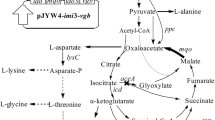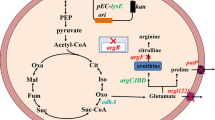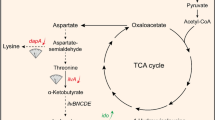Abstract
4-Hydroxyisoleucine (4-HIL) is a nonproteinogenic amino acid that exhibits insulinotropic biological activity. Here, L-isoleucine dioxygenase gene (ido) derived from Bacillus thuringiensis YBT-1520 was cloned and expressed in an L-isoleucine-producing strain, Corynebacterium glutamicum ssp. lactofermentum SN01, in order to directly convert its endogenous L-isoleucine (Ile) into 4-HIL through single-step fermentation. The effects of corn steep liquor limitation as well as ido and truncated idoΔ6 overexpression on 4-HIL production were researched. 4-HIL production by ido-overexpressing strain was improved to 65.44 ± 2.27 mM after fermented for 144 h under corn steep liquor–subsufficient condition, obviously higher than that under corn steep liquor–rich and insufficient conditions. The conversion ratio of Ile to 4-HIL increased to 0.85 mol/mol. In addition, 4-HIL production by ido-overexpressing strain was higher than that by idoΔ6-overexpressing strain, in accord with the relatively higher affinity of Ido as compared to IdoΔ6. This research generated a novel system for 4-HIL de novo biosynthesis and demonstrated corn steep liquor limitation as a useful strategy for improving 4-HIL production in recombinant C. glutamicum ssp. lactofermentum.






Similar content being viewed by others
References
Alcock NW, Crout DHG, Gregorio MVM, Lee E, Pike G, Samuel CJ (1989) Stereochemistry of the 4-hydroxyisoleucine from Trigonella foenum-graecum. Phytochemistry 28:1835–1841
Asakura Y, Kimura E, Usuda Y, Kawahara Y, Matsui K, Osumi T, Nakamatsu T (2007) Altered metabolic flux due to deletion of odhA causes L-glutamate overproduction in Corynebacterium glutamicum. Appl Environ Microbiol 73:1308–1319. doi:10.1128/AEM. 01867-06
Blombach B, Schreiner ME, Holatko J, Bartek T, Oldiges M, Eikmanns BJ (2007) L-valine production with pyruvate dehydrogenase complex-deficient Corynebacterium glutamicum. Appl Environ Microbiol 73:2079–2084. doi:10.1128/AEM. 02826-06
Broca C, Gross R, Petit P, Sauvaire Y, Manteghetti M, Tournier M, Masiello P, Gomis R, Ribes G (1999) 4-Hydroxyisoleucine: experimental evidence of its insulinotropic and antidiabetic properties. Am J Physiol Endocrinol Metab 277:E617–E623
Broca C, Manteghetti M, Gross R, Baissac Y, Jacob M, Petit P, Sauvaire Y, Ribes G (2000) 4-Hydroxyisoleucine: effects of synthetic and natural analogues on insulin secretion. Eur J Pharmacol 390:339–345. doi:10.1016/S0014-2999(00)00030-3
Broca C, Breil V, Cruciani-Guglielmacci C, Manteghetti M, Rouault C, Derouet M, Rizkalla S, Pau B, Petit P, Ribes G, Ktorza A, Gross R, Reach G, Taouis M (2004) Insulinotropic agent ID-1101 (4-hydroxyisoleucine) activates insulin signaling in rat. Am J Physiol Endocrinol Metab 287:E463–E471. doi:10.1152/ajpendo.00163.2003
Cao Y, Duan ZY, Shi ZP (2014) Effect of biotin on transcription levels of key enzymes and glutamate efflux in glutamate fermentation by Corynebacterium glutamicum. World J Microbiol Biotechnol 30:461–468. doi:10.1007/s11274-013-1468-0
Eidi A, Eidi M, Sokhteh M (2007) Effect of fenugreek (Trigonella foenum-graecum L) seeds on serum parameters in normal and streptozotocin-induced diabetic rats. Nutr Res 27:728–733. doi:10.1016/j.nutres.2007.09.006
Fowden L, Pratt HM, Smith A (1973) 4-Hydroxyisoleucine from seed of Trigonella foenum-graecum. Phytochemistry 12:1707–1711
Haeri MR, Limaki HK, White CJ, White KN (2012) Non-insulin dependent anti-diabetic activity of (2S, 3R, 4S) 4-hydroxyisoleucine of fenugreek (Trigonella foenum graecum) in streptozotocin- induced type I diabetic rats. Phytomedicine 19:571–574. doi:10.1016/j.phymed.2012.01.004
Hibi M, Kawashima T, Kodera T, Smirnov SV, Sokolov PM, Sugiyama M, Shimizu S, Yokozeki K, Ogawa J (2011) Characterization of Bacillus thuringiensis L-isoleucine dioxygenase for production of useful amino acids. Appl Environ Microbiol 77:6926–6930. doi:10.1128/AEM. 05035-11
Hirasawa T, Kim J, Shirai T, Furusawa C, Shimizu H (2012) Molecular mechanisms and metabolic engineering of glutamate overproduction in Corynebacterium glutamicum. Subcell Biochem 64:261–281. doi:10.1007/978-94-007-5055-5_13
Hu JY, Li YY, Zhang HL, Tan YZ, Wang XY (2014) Construction of a novel expression system for use in Corynebacterium glutamicum. Plasmid 75:18–26. doi:10.1016/j.plasmid.2014.07.005
Ikeda M, Nakagawa S (2003) The Corynebacterium glutamicum genome: features and impacts on biotechnological processes. Appl Microbiol Biotechnol 62:99–109. doi:10.1007/s00253-003-1328-1
Jaiswal N, Maurya CK, Venkateswarlu K, Sukanya P, Srivastava AK, Narender T, Tamrakar AK (2012) 4-Hydroxyisoleucine stimulates glucose uptake by increasing surface GLUT4 level in skeletal muscle cells via phosphatidylinositol-3-kinase-dependent pathway. Eur J Nutr 51:893–898. doi:10.1007/s00394-012-0374-9
Kalinowski J, Bathe B, Bartels D, Bischoff N, Bott M, Burkovski A, Dusch N, Eggeling L, Eikmanns BJ, Gaigalat L, Goesmann A, Hartmann M, Huthmacher K, Kramer R, Linke B, McHardy AC, Meyer F, Mockel B, Pfefferle W, Puhler A, Rey DA, Ruckert C, Rupp O, Sahm H, Wendisch VF, Wiegrabe I, Tauch A (2003) The complete Corynebacterium glutamicum ATCC 13032 genome sequence and its impact on the production of L-aspartate-derived amino acids and vitamins. J Biotechnol 104:5–25. doi:10.1016/S0168-1656(03)00154-8
Kawahara Y, Takahashi-Fuke K, Shimizu E, Nakamatsu T, Nakamori S (1997) Relationship between the glutamate production and the activity of 2-oxoglutarate dehydrogenase in Brevibacterium lactofermentum. Biosci Biotechnol Biochem 61:1109–1112
Kennerknecht N, Sahm H, Yen MR, Patek M, Saier MH, Eggeling L (2002) Export of L-isoleucine from Corynebacterium glutamicum: a two-gene-encoded member of a new translocator family. J Bacteriol 184:3947–3956. doi:10.1128/JB.184.14.3947-3956.2002
Kimura E (2003) Metabolic engineering of glutamate production. Adv Biochem Eng Biotechnol 79:37–57
Kivero AD, Novikova AE, Smirnov SV (2012) Modification of E. coli central metabolism to optimize the biotransformation of L-isolecucine into 4-hydroxyisoleucine by enzymatic hydroxylation. Appl Biochem Microbiol 48:639–644. doi:10.1134/S0003683812070034
Kodera T, Smirnov SV, Samsonova NN, Kozlov YI, Koyama R, Hibi M, Ogawa J, Yokozeki K, Shimizu S (2009) A novel L-isoleucine hydroxylating enzyme, L-isoleucine dioxygenases from Bacillus thuringiensis, produces (2S,3R,4S)-4-hydroxyisoleucine. Biochem Biophys Res Commun 390:506–510. doi:10.1016/j.bbrc.2009.09.126
Lv Y, Liao J, Wu Z, Han S, Lin Y, Zheng S (2012) Genome sequence of Corynebacterium glutamicum ATCC 14067, which provides insight into amino acid biosynthesis in coryneform bacteria. J Bacteriol 194:742–743. doi:10.1128/JB.06514-11
Maurya CK, Singh R, Jaiswal N, Venkateswarlu K, Narender T, Tamrakar AK (2014) 4-Hydroxyisoleucine ameliorates fatty acid-induced insulin resistance and inflammatory response in skeletal muscle cells. Mol Cell Endocrinol 395:51–60. doi:10.1016/j.mce.2014.07.018
Narender T, Puri A, Shweta KT, Saxena R, Bhatia G, Chandra R (2006) 4-hydroxyisoleucine an unusual amino acid as antidyslipidemic and antihyperglycemic agent. Bioorg Med Chem Lett 16:293–296. doi:10.1016/j.bmcl.2005.10.003
Ogawa J, Kodera T, Smirnov SV, Hibi M, Samsonova NN, Koyama R, Yamanaka H, Mano J, Kawashima T, Yokozeki K, Shimizu S (2011) A novel L-isoleucine metabolism in Bacillus thuringiensis generating (2S,3R,4S)-4-hydroxyisoleucine, a potential insulinotropic and anti-obesity amino acid. Appl Microbiol Biotechnol 89:1929–1938. doi:10.1007/s00253-010-2983-7
Park JH, Lee SY (2010) Fermentative production of branched chain amino acids: a focus on metabolic engineering. Appl Microbiol Biotechnol 85:491–506. doi:10.1007/s00253-009-2307-y
Sato H, Orishimo K, Shirai T, Hirasawa T, Nagasawa K, Shimizu H, Wachi M (2008) Distinct roles of two anaplerotic pathways in glutamate production induced by biotin limitation in Corynebacterium glutamicum. J Biosci Bioeng 106:51–58. doi:10.1263/jbb.106.51
Sauvaire Y, Petit P, Broca C, Manteghetti M, Baissac Y, Fernandez-Alvarez J, Gross R, Roye M, Leconte A, Gomis R, Ribes G (1998) 4-Hydroxyisoleucine: a novel amino acid potentiator of insulin secretion. Diabetes 47:206–210. doi:10.2337/diabetes.47.2.206
Schneider J, Peters-Wendisch P, Stansen KC, Gotker S, Maximow S, Kramer R, Wendisch VF (2012) Characterization of the biotin uptake system encoded by the biotin-inducible bioYMN operon of Corynebacterium glutamicum. BMC Microbiol 12:6. doi:10.1186/1471-2180-12-6
Shi F, Huan XJ, Wang XY, Ning JF (2012) Overexpression of NAD kinases improves the L-isoleucine biosynthesis in Corynebacterium glutamicum ssp. lactofermentum. Enzym Microbiol Technol 51:73–80. doi:10.1016/j.enzmictec.2012.04.003
Shi F, Li K, Huan XJ, Wang XY (2013) Expression of NAD(H) kinase and glucose-6-phosphate dehydrogenase improve NADPH supply and L-isoleucine biosynthesis in Corynebacterium glutamicum ssp. lactofermentum. Appl Biochem Biotechnol 171:504–521. doi:10.1007/s12010-013-0389-6
Singh AB, Tamarkar AK, Narender T, Srivastava AK (2010) Antihyperglycaemic effect of an unusual amino acid (4-hydroxyisoleucine) in C57BL/KsJ-db/db mice. Nat Prod Res 24:258–265. doi:10.1080/14786410902836693
Smirnov SV, Kodera T, Samsonova NN, Kotlyarova VA, Rushkevich NY, Kivero AD, Sokolov PM, Hibi M, Ogawa J, Shimizy S (2010) Metabolic engineering of Escherichia coli to produce (2S,3R,4S)-4-hydroxyisoleucine. Appl Microbiol Biotechnol 88:719–726. doi:10.1007/s00253-010-2772-3
Towbin H, Staehelin T, Gordon J (1979) Electrophoretic transfer of proteins from polyacrylamide gels to nitrocellulose sheets: procedure and some applications. Biotechnology 24:145–149
Wu D, He J, Gong Y, Chen D, Zhu X, Qiu N, Sun M, Li M, Yu Z (2011) Proteomic analysis reveals the strategies of Bacillus thuringiensis YBT-1520 for survival under long-term heat stress. Proteomics 11:2580–2591. doi:10.1002/pmic.201000392
Yin LH, Shi F, Hu XQ, Chen C, Wang XY (2013) Increasing l-isoleucine production in Corynebacterium glutamicum by overexpressing global regulator Lrp and two-component export system BrnFE. J Appl Microbiol 114:1369–1377. doi:10.1111/jam.12141
Yukawa H, Omumasaba CA, Nonaka H, Kos P, Okai N, Suzuki N, Suda M, Tsuge Y, Watanabe J, Ikeda Y, Vertes AA, Inui M (2007) Comparative analysis of the Corynebacterium glutamicum group and complete genome sequence of strain R. Microbiology 153:1042–1058. doi:10.1099/mic. 0.2006/003657-0
Zhang D, Liang N, Shi Z, Liu L, Chen J, Du G (2009) Enhancement of α-ketoglutarate production in Torulopsis glabrata: redistribution of carbon flux from pyruvate to α-ketoglutarate. Biotechnol Bioprocess Eng 14:134–139. doi:10.1007/s12257-008-0169-2
Acknowledgments
The authors thank the “Program of State Key Laboratory of Food Science and Technology” (contract no. SKLF-ZZB-201405 and SKLF-ZZB-201501) for financial support.
Author information
Authors and Affiliations
Corresponding author
Additional information
Feng Shi and Tengfei Niu contributed equally to this work.
Rights and permissions
About this article
Cite this article
Shi, F., Niu, T. & Fang, H. 4-Hydroxyisoleucine production of recombinant Corynebacterium glutamicum ssp. lactofermentum under optimal corn steep liquor limitation. Appl Microbiol Biotechnol 99, 3851–3863 (2015). https://doi.org/10.1007/s00253-015-6481-9
Received:
Revised:
Accepted:
Published:
Issue Date:
DOI: https://doi.org/10.1007/s00253-015-6481-9




